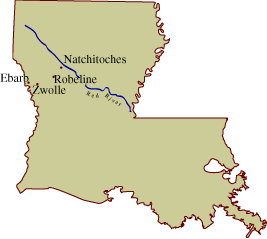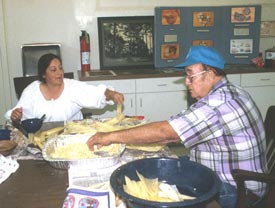Making Tamales in Northwestern Louisiana
 The Red River Valley has a strong Spanish and Indo-Spanish tradition. In both the Ebarb and Zwolle area in Sabine Parish, and the Spanish Lake area in Natchitoches Parish, small communities developed out of the core population which once inhabited the Spanish presidio, Nuestra Señora Del Pilar De Los Adaes. This presidio was established in 1721, in response to the French establishment of Fort St. Jean Baptiste des Natchitoches. The original inhabitants were primarily soldiers, some Spanish and some metizo (people of mixed Spanish and Indian, in this case Cohuilitecan, origin). After the presidio was established near present-day Robeline, some of the soldiers are said to have married local women of the Caddo and the Adai Indians. It is known that they married French women from Natchitoches and Apache women, who were enslaved by the Wichita, the French and the Spaniards.
The Red River Valley has a strong Spanish and Indo-Spanish tradition. In both the Ebarb and Zwolle area in Sabine Parish, and the Spanish Lake area in Natchitoches Parish, small communities developed out of the core population which once inhabited the Spanish presidio, Nuestra Señora Del Pilar De Los Adaes. This presidio was established in 1721, in response to the French establishment of Fort St. Jean Baptiste des Natchitoches. The original inhabitants were primarily soldiers, some Spanish and some metizo (people of mixed Spanish and Indian, in this case Cohuilitecan, origin). After the presidio was established near present-day Robeline, some of the soldiers are said to have married local women of the Caddo and the Adai Indians. It is known that they married French women from Natchitoches and Apache women, who were enslaved by the Wichita, the French and the Spaniards.
Although the presidio closed in 1773, when the inhabitants were ordered to relocate to San Antonio, many of the Adaesaños (people of Adaes) refused to leave. Some moved north and settled in present-day DeSoto and Sabine Parishes, and some remained near present-day Robeline in Natchitoches Parish. These multi-cultural communities subdivided into ethnic enclaves of people who self-identified as Spanish, Adai-Caddo, or Choctaw-Apache, depending upon family and community tradition.
Rhonda Remedies Gauthier & John Remedies

Rhonda Remedies Gauthier and her father, John Remedies, exemplify the nature of these complex communities. Rhonda, who identifies herself as an Adaesaño, is an enrolled member of the Choctaw-Apache Tribe of Sabine Parish. Her mother was Apache and Spanish, and her father is of Cohuilitecan, Spanish, and French heritage. Rhonda learned how to cook from her mother, her grandmothers, and her father. At 76 years old, Mr. Remedies has just recently stopped planting crops, which he still plowed with a mule. However, he continues to advise Rhonda on how to make tamales and other traditional Indo-Hispanic foods.
In the old days, the first step in the process was to kill a hog in the fall or winter and process the meat. Nowadays, however, one can purchase the pork roast, peppers, crushed red pepper, garlic, salt and pepper. Dried corn is boiled with ashes to remove the skin from the kernals. The corn is then ground to make the masa, which will be used in the tamales. As part of an interpretive program, Rhonda and Mr. Remedies demonstrated the art of tamale making at Los Adaes State Historic Site near Robeline.
Preparation for Making Tamales
The basic supplies for making tamales. The metate is the basalt base and the mano is the basalt grinder, which are used together for grinding hominy. Also pictured are corn shucks, hominy, meat, and seasonings.

A nice, large pan of masa (ground hominy) and corn shucks. Everything is set up for Rhonda and Mr. John to begin daubing the tamales. Daubing is a method in which the masa is applied to the corn shuck. A portion of the masa is applied to the shuck, then daubed on and spread with the thumbs.

Mr. John is washing the corn shucks and placing them in a standing position in the pan. The shucks are placed with the tops down, so the water will run off. In this way, as they dry they will get enough air circulation so that they will not mold.

Standing shucks and masa.
Daub the Tamales

Rhonda and Mr. John begin to daub the tamales.

Rhonda has filled her tamale with meat and is wrapping it.

Daubed tamales before being filled with meat.
Roll the Tamales

Mr. Remedies jokes with Rhonda about the "correct" way to roll tamales. Mr. John carefully rolls his tamales, tucks the ends under, and ties them with small strips of shuck, while Rhonda does not generally tie hers.

Rhonda is trying her hand at rolling tamales the way her father has instructed.

A large pan of tamales ready to go into a cooler, or into a pot to cook. This pan contains about 20 dozen tamales. Mr. John's are the ones that are neatly tied!
Cook and Eat the Tamales

Rhonda is removing the tamales from a large, cast iron kettle. The tamales were steamed over an open-pit cooking area at Los Adaes State Historic Site.

Rhonda is removing the tamales from the kettle.

Rhonda's daughter and grandson, Marsha LaRue and Trey Dees, are helping serve tamales to visitors at Los Adaes.

A group of visitors enjoying the tamales that Mr. Remedies and Rhonda have prepared.